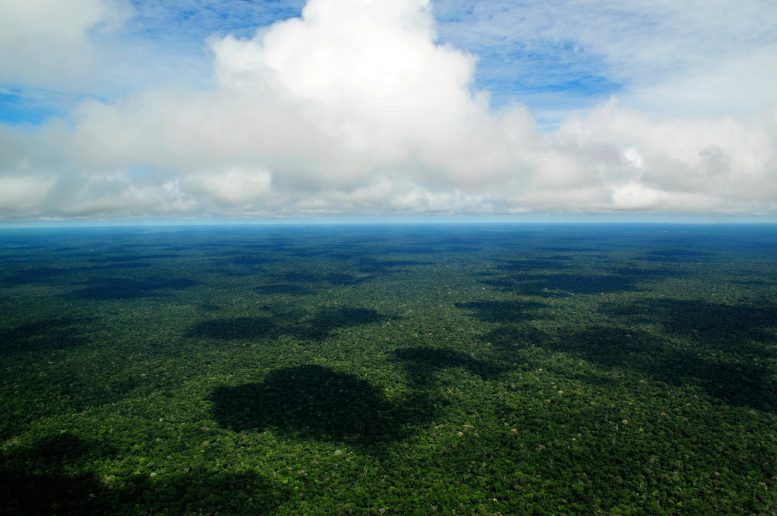Deforestation in the tropics is an even more important factor in the climate cycle than previously thought —including changes in the circulation of heat and water— according to a new study from a team including researchers at the Alliance of Bioversity International and CIAT.
Forests and their loss through deforestation have long been factored into climate calculations with regards to the amount of carbon that goes into the atmosphere when forest cover is lost.
But a new study, published in March 2022 in the journal Frontiers in Forests and Global Change, examined how a range of biophysical factors are changed by deforestation, including albedo, wind patterns, and local heat distribution; and also cloud composition and water cycles.
In the paper, “The unseen effects of deforestation: biophysical effects on climate,” the authors explain their analysis is the first to compare regional scale biophysical and carbon dioxide impacts from regional-scale deforestation.
Biophysical Effects
Deborah Lawrence, the lead author of the paper and a professor at the University of Virginia, says although climate models do incorporate the biophysical effects of deforestation, policymakers don’t always have this in mind when they are making their decisions about land use.
One of the main biophysical effects of deforestation the researchers looked at was how the loss of forest cover impacts heat distribution. High tree canopies, like those found in forests, push heat away from the surface and distribute it higher in the atmosphere.
“Imagine a smooth surface, the wind just flows straight across and the heat from the sun comes straight down,” she said, “But with the canopy and its surface like a crown of broccoli, those air parcels bounce around and the heat is dispersed.”
In the same way that an umbrella disperses heavy water fall and keeps the person underneath dry, forests play this biophysical role when it comes to heat.
“Keeping the heat away from the ground is important, because we live down here,” Lawrence said. “Temperature rises are measured at ground level.”
Louis Verchot, a principal scientist at the Alliance of Bioversity International and CIAT based in Cali, Colombia says another important biophysical factor is the water cycle.
“Forests are also important to regional hydrological cycles; once you cut the trees, you remove the pump that transfers water from the surface to the atmosphere, which affects down-wind rainfall,” Vercho said.
Forests are also a main source of biogenic volatile organic compounds (BVOCs), which are one of the many factors involved in cloud formation. “The BVOCs produced by forests increase the concentration of water droplets in clouds, which makes them brighter so they reflect more energy back to space.”
Verchot says while the interactions of condensation nuclei (around which clouds form) are complex, it is becoming clearer that there are both indirect and direct effects on clouds from the changes in BVOCs associated with deforestation.
“We used to think the biophysical effects offset each other, but we now know that removing forests greatly reduces the cooling effects of clouds,” he said.
A “Landscape Systems” Perspective
Verchot says that although CIAT, as the International Center for Tropical Agriculture, has agronomists and the plant breeders, they also take a landscape systems approach, understanding the importance of other types of ecosystems in the landscapes and the roles they play and the services they provide to society.
“The group I’m based in is focused on the Amazon, looking at fire, deforestation, and the loss of wetlands in Latin America… both from the carbon cycle and hydrological cycle perspectives,” he said, adding that the Alliance is an applied research center that looks at the impact of those things on human wellbeing, including poverty, small-scale farming and the ability of countries to feed themselves.
“We are helping to explain to governments and to policymakers that there are economic advantages to preventing deforestation and having forests in these regions provides an economic safety net, because we don’t just look at it from a carbon perspective,” Verchot said.
It’s not just policymakers from the tropics that should take this into account either.
“If we are looking for aggregate climate benefits, both local and global, then we should be working very hard to grow and maintain forests in the tropics and looking to sustainably manage the forests outside the tropics,” Lawrence said.
Reference: “The Unseen Effects of Deforestation: Biophysical Effects on Climate” by Deborah Lawrence, Michael Coe, Wayne Walker, Louis Verchot and Karen Vandecar, 24 March 2022, Frontiers in Forests and Global Change.
DOI: 10.3389/ffgc.2022.756115










Be the first to comment on "Deforestation Impacts Go Far Beyond Carbon: Range of Biophysical Factors Are Changed"